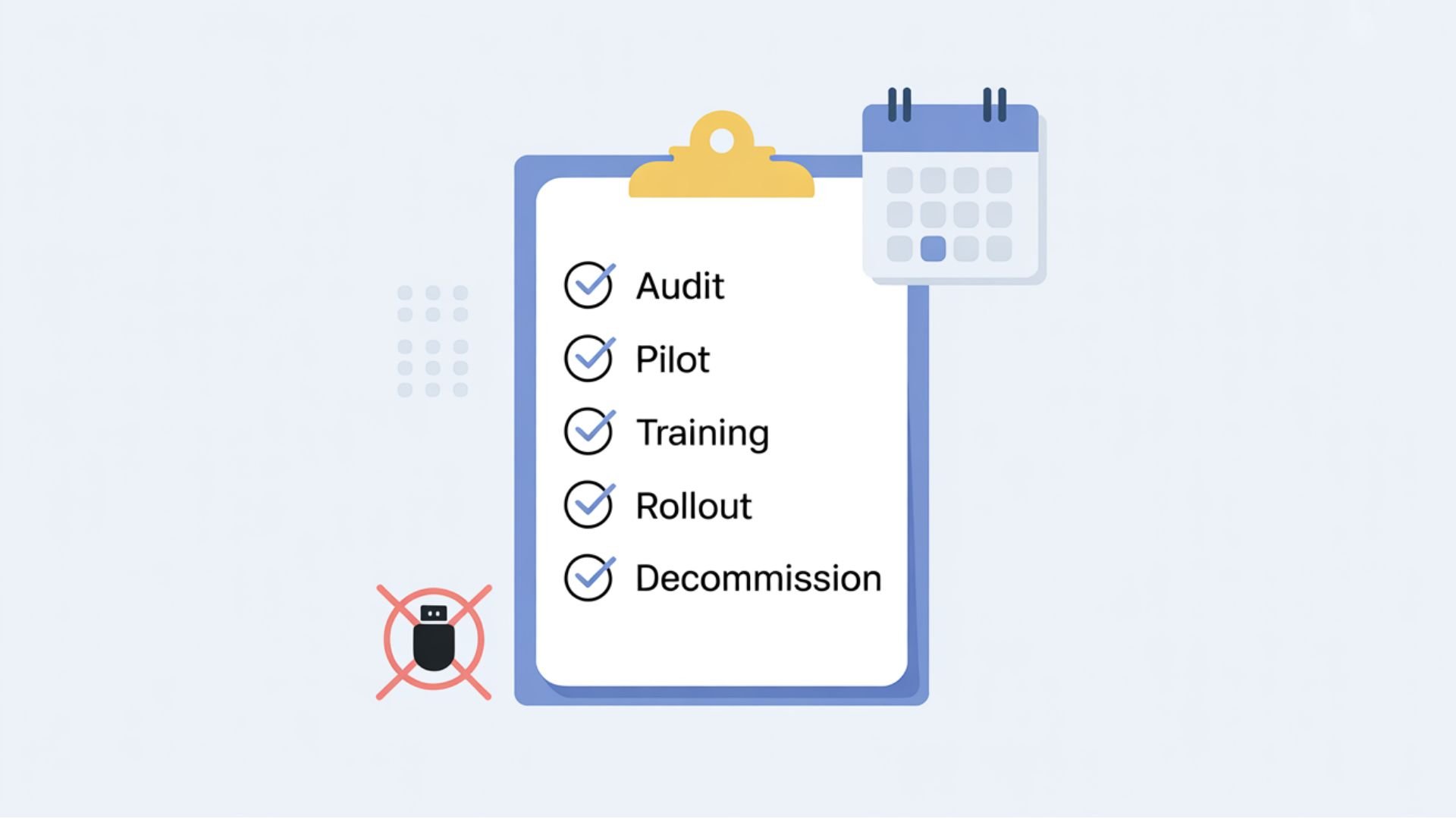Office 2016/2019 Support Has Ended - The Definitive Australian Business Guide
What end of support means, risks to Australian organisations, upgrade paths, migration tips, case studies, FAQs, and Nexacu training
As of 14 October 2025, Microsoft has ended support for Office 2016 and Office 2019. Unsupported Office creates security, compliance, and reliability risks, but it’s also a chance to modernise, streamline workflows, and unlock AI. This Australian-focused guide distils what to do next, with actionable steps, upgrade options, and training pathways. Sources: BleepingComputer, MicroChannel.
Executive key takeaways
- • Support ended: Office 2016/2019 reached end of support on 14 Oct 2025 - no further security updates or fixes.
- • Risk: Unsupported apps increase cyber exposure, compliance failures, and downtime.
- • Most organisations: Move to Microsoft 365 Apps for continuous updates, Teams/OneDrive integration, and Copilot.
- • Regulated/air-gapped: Consider Office LTSC 2024 (perpetual, security updates to 2029, no new features).
- • Action plan: Audit → pilot → train → phase rollout → decommission legacy → verify compliance.
Explore upgrade options: Microsoft guidance
Jump to: What “end of support” means • Security & compliance implications • Quick reference table • Upgrade options • Migration tips • Case studies • FAQs • Stats & facts • Nexacu training • Checklists • Resources • Get started
Introduction: why this matters now
End of support (EoS) means no more security updates, bug fixes, or Microsoft support for Office 2016/2019. From today onward, risk exposure rises, integrations (Teams, Exchange Online, SharePoint) will break over time, and IT inherits incidents without vendor backing. For prepared organisations, this is the perfect moment to modernise, uplift security, and equip teams with cloud collaboration and AI.
This guide is written for Australian organisations - covering security, compliance, upgrade paths, and hands-on steps tailored to local realities.
What does “end of support” mean?
- No new security patches or bug fixes after 14 Oct 2025.
- Microsoft help desk support is unavailable for these versions.
- Cloud integrations will degrade (Teams, OneDrive, SharePoint, Exchange Online).
- Compliance exposure grows, and cyber insurance may require supported software.
More info: InvGate EoL explainer

The implications: security, compliance, workflow
Security vulnerabilities
Unsupported Office is a prime target for malware and phishing, especially macro-borne threats. Without patches, new exploits stay open indefinitely.
Compliance and legal risk
Standards and frameworks (for example, ISO 27001 and APRA CPS 234) require patched, supported software. Using EoS Office can threaten audits, contracts, and cyber insurance.
Broken workflows and integrations
Expect degraded co-authoring, calendaring, and file-sharing with Microsoft 365 services. Add-ins and VBA automations may fail as Windows and cloud services evolve.

Quick reference table
| Topic | Office 2016/2019 (EoS) | Microsoft 365 Apps | Office LTSC 2024 |
|---|---|---|---|
| Security updates | No after 14 Oct 2025 | Yes, ongoing | Yes (to 2029) |
| Cloud integration | Degrading or unsupported | Full (Teams, OneDrive, SharePoint) | Minimal (by design) |
| AI/Copilot | None | Yes (subscription) | No |
| Compliance posture | High risk | Best for most orgs | Best for offline or regulatory needs |
| Licence type | Perpetual (legacy) | Subscription | Perpetual |
Upgrade options: which path fits your business?
Microsoft 365 Apps (recommended for most)
Continuously updated Office apps with deep Teams and SharePoint integration and access to Copilot. Ideal for distributed, hybrid, or growing teams needing collaboration and modern security.
- Monthly security and feature updates
- Real-time co-authoring and cloud file management
- AI assistance (where licensed) for drafting, analysis, and meeting summaries
Learn more: MicroChannel guide
Office LTSC 2024 (for regulated or offline needs)
Perpetual licence intended for fixed, controlled environments. Receives security updates through 2029 but no new features or Copilot. Suits air-gapped networks or strict regulatory contexts.
- Local or per-device installation and offline operation
- Predictable change windows with minimal integration by design
- Better fit for legacy macros or templates that cannot be refactored quickly
Compare options: LTSC vs Microsoft 365

Tips for a fast, low-risk migration
- Audit all Office installs, add-ins, macros, and downstream dependencies.
- Segment needs: who goes Microsoft 365, who requires LTSC 2024.
- Pilot with a representative group, and validate key workflows and templates.
- Back up mail, templates, and key data before changes.
- Deliver role-based training covering Teams, OneDrive, SharePoint, and Copilot.
- Phase the rollout, and prioritise high-risk or compliance-impacted teams.
- Track issues during the pilot, and fix before scaling.
- Communicate early and often, and provide quick-reference guides and FAQs.
- Decommission legacy Office to eliminate shadow use.
- Re-check compliance posture after migration.

Case studies: lessons in success and failure
Manufacturing SME, Sydney
Problem: Office 2016 macros and add-ins began failing with newer services.
Solution: Audit → Microsoft 365 pilot → Nexacu training in Teams, Excel, and Copilot.
Outcome: No disruption, 60% fewer support tickets, faster forecasting.
Legal services provider
Problem: Audit flagged unsupported Office 2019, and client trust was at risk.
Solution: Office LTSC 2024 rollout, macro and template remediation, and targeted training.
Outcome: Passed compliance, protected confidentiality, and reduced incident risk.
FAQs: your Office 2016/2019 EoS questions answered
Can we ignore the deadline?
Not safely. Security exposure and compatibility failures will mount, and insurance and compliance may be affected.
Are Copilot and AI available with perpetual Office?
No. Copilot is available with Microsoft 365 subscriptions only.
What about our macros and add-ins?
Most migrate, but always test in a sandbox first. Plan remediation for hard-coded paths or legacy COM add-ins.
We’re not ready - what should we do?
Start with an audit and a pilot. Even partial migration post-deadline significantly reduces risk.
Essential stats and facts
- Ransomware and phishing frequently target unpatched Office vulnerabilities.
- Australian MSPs report rapid shifts to Microsoft 365 to meet compliance and reduce maintenance overhead.
- Copilot can save meaningful hours per user yearly through automation and summarisation.
References: [1] BleepingComputer • [2] MicroChannel • [3] InvGate • [4] LTSC vs 365 • [5] Microsoft
Nexacu training solutions: upskill your team
- • Microsoft 365 Workshops - Teams, OneDrive, SharePoint, Outlook, and Copilot.
- • Excel & Power Query - modelling, automation, audit-ready reporting.
- • Copilot productivity sessions - role-based AI workflows.
- • Change management and migration advisory - playbooks, comms packs, Q&A clinics.
Checklists and tools
Post-EoS actions (start now)
- Inventory all Office licences, versions, and add-ins.
- Identify workflow dependencies (macros, integrations).
- Segment cloud vs LTSC needs.
- Nominate pilot users and success criteria.
- Schedule Nexacu training and internal comms.
After migration
- Verify licensing and updates across all devices.
- Validate data integrity and access.
- Gather user feedback, and iterate training.
- Run a compliance spot-check.
- Decommission any remaining legacy Office.
Resources and references
- [1] Office 2016/2019 reach end of support (BleepingComputer)
- [2] What you need to know (MicroChannel)
- [3] End-of-life overview (InvGate)
- [4] Office LTSC 2024 vs Microsoft 365
- [5] Microsoft upgrade options
Conclusion: support has ended - act now
With Office 2016/2019 support now over, decisive action is essential. Australian organisations that audit, pilot, train, and migrate immediately will reduce risk, meet compliance, and unlock modern productivity, including AI with Copilot. Nexacu’s trainers and advisors can guide planning, capability building, and a smooth rollout.


























